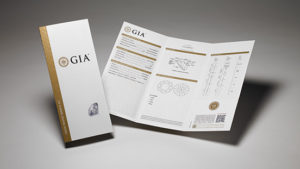How to tell if your diamond certificate and appraisal are legitimate.

Starting the diamond buying process by educating one’s self about diamonds is the smart thing to do. Learning the Gemological Institute of America’s “4 C’s” of diamond quality to help determine how best your money is spent is important. Many diamonds these days are accompanied by a “diamond certificate” or diamond grading report. This is a third-party assessment of quality factors. But how do you know if your diamond certificate is legitimate or even worth the paper it’s printed on?
I was driven to write about this subject after having a few separate clients seek an appraisal on their recent new diamond purchases. Each of these clients had bought their diamond rings online. They all felt like they had done their due diligence in determining what quality of diamond they intended on purchasing. And the rings were delivered with what appeared to be an authentic lab report issued by the Gemological Institutes Services (GIS).
But it turns out the diamond certificate delivered with their new ring was bogus. Not only was the clarity overstated, resulting in a gross exaggeration of quality. The “replacement value” reported was also extremely inflated, indicating that the diamond was worth triple the price paid. As it turns out, all the diamonds were very low quality (I-2 to I-3) and had been clarity enhanced to improve their appearance. The clarity enhancement used is called “fracture filling” and is a process by which leaded glass is injected by vacuum into fissures inside the diamond. Fracture filling is relatively stable. But it can be damaged with heat during repairs and sometimes harsh chemicals used in cleaning products. None of my clients were aware they had purchased a treated diamond. Furthermore, the clarity grade stated on each of these so-called “diamond certificates” did not accurately reflect the apparent clarity post-treatment.
Did they get what they paid for?
Yes and no. Was the price they paid fair for what they received? Yes. Were they accurately informed about what they were getting? No. You’ve likely heard the proverb, “You can put lipstick on a pig, but it’s still a pig.” The GIS diamond certificate is the lipstick in this case.
How to avoid a similar experience when shopping for diamonds? Look for a diamond certificate, or grading report, issued by the Gemological Institute of America (GIA). GIA is the leading authority on diamonds and diamond grading. Accept nothing less and you are guaranteed accurate reporting of diamond qualities and any treatments that may be present.
Also, take a look at the appraisal that may have been issued with your purchase. If the replacement cost stated is well above your purchase price, consider that a red flag and get a second opinion. The seller of your new ring is motivated to make you feel that you received an exceptional deal. That inflated value will only disserve you.
When insuring your new ring, the premium you pay is, in large part, related to the value stated on your appraisal. And, if you suffer a loss, your insurance company is most certainly not going to pay out more than your diamond is really worth. Don’t get sucked into paying more in insurance premiums than you should. If you feel you have an inflated appraisal, seek out an independent jewelry appraiser for an accurate assessment and appraisal report.

